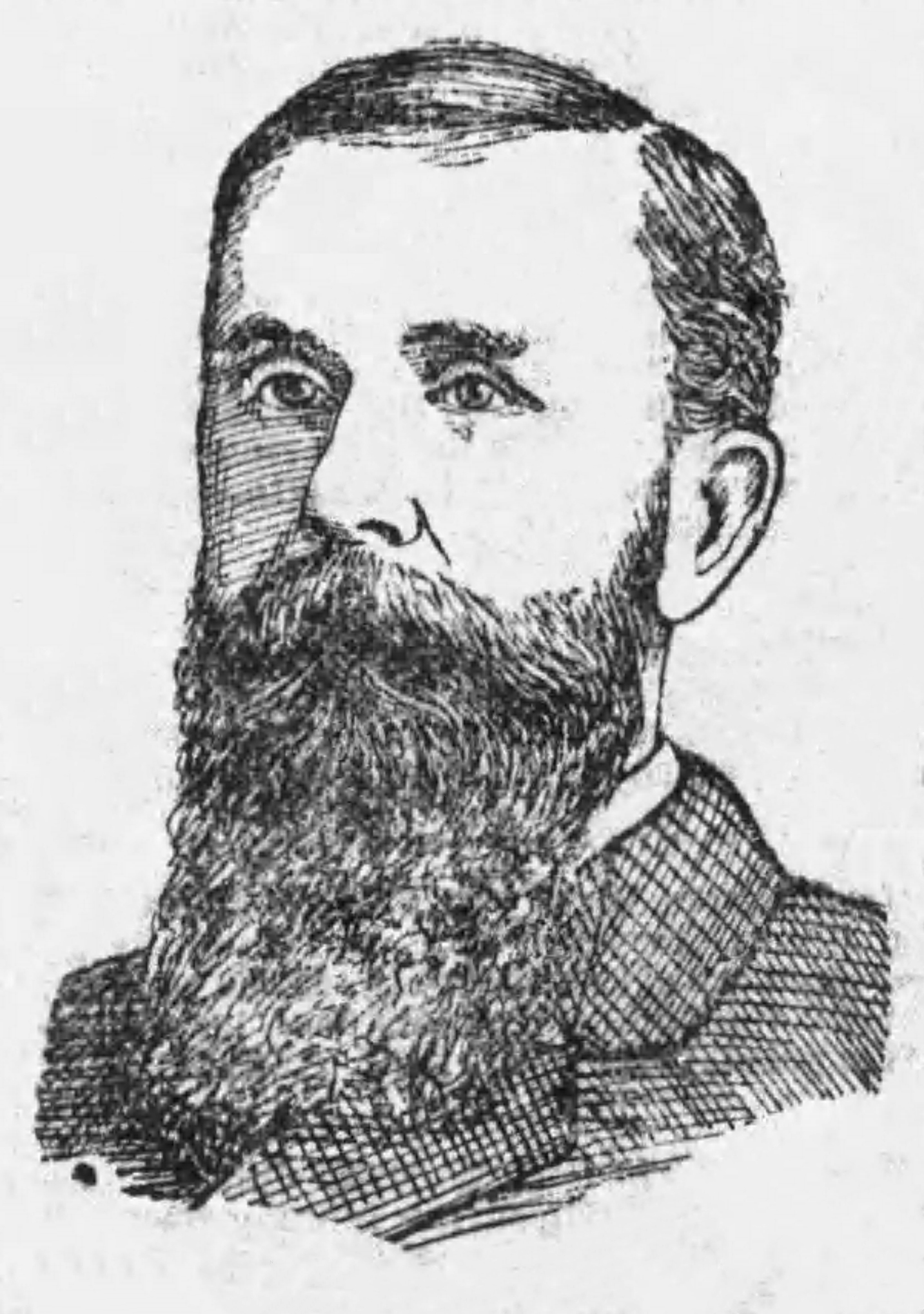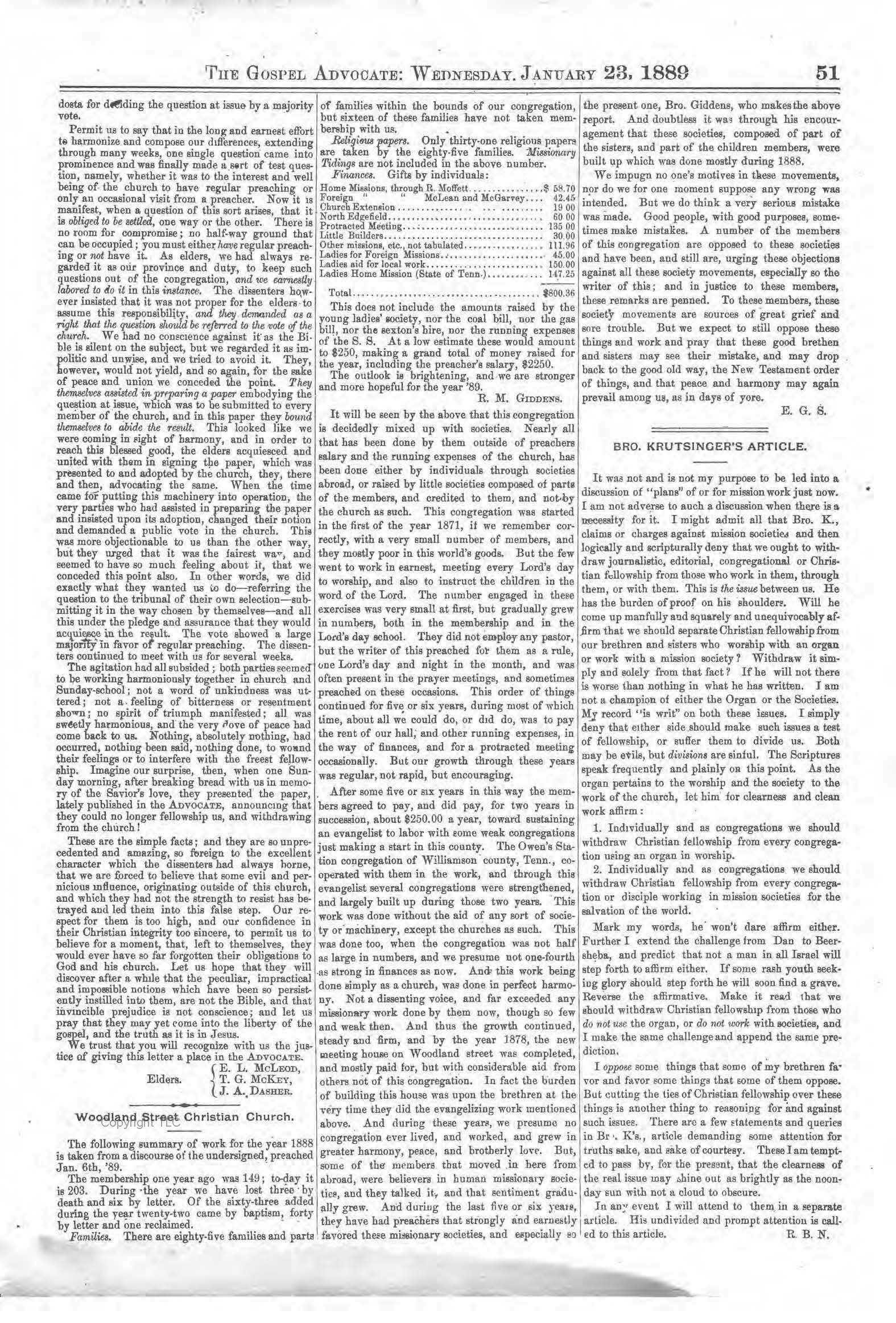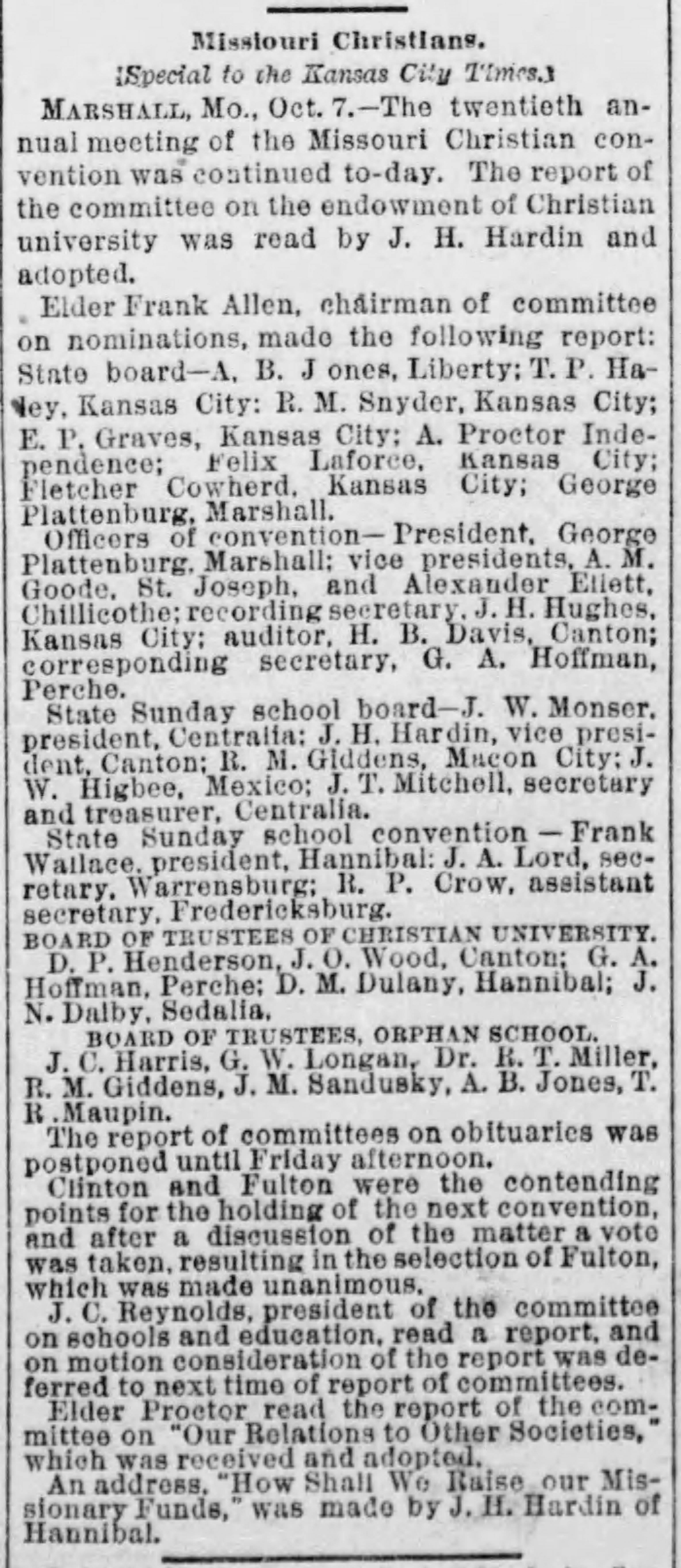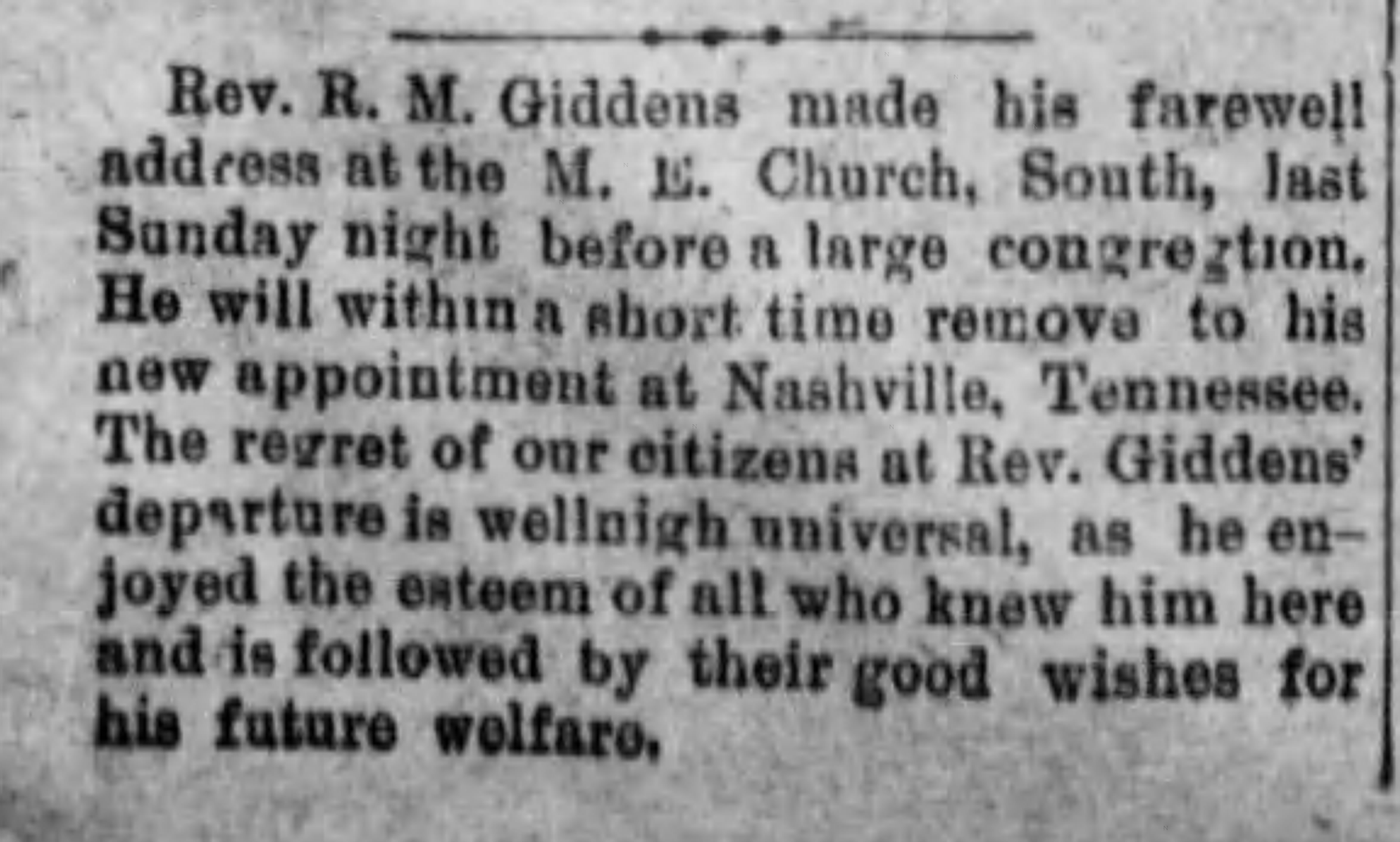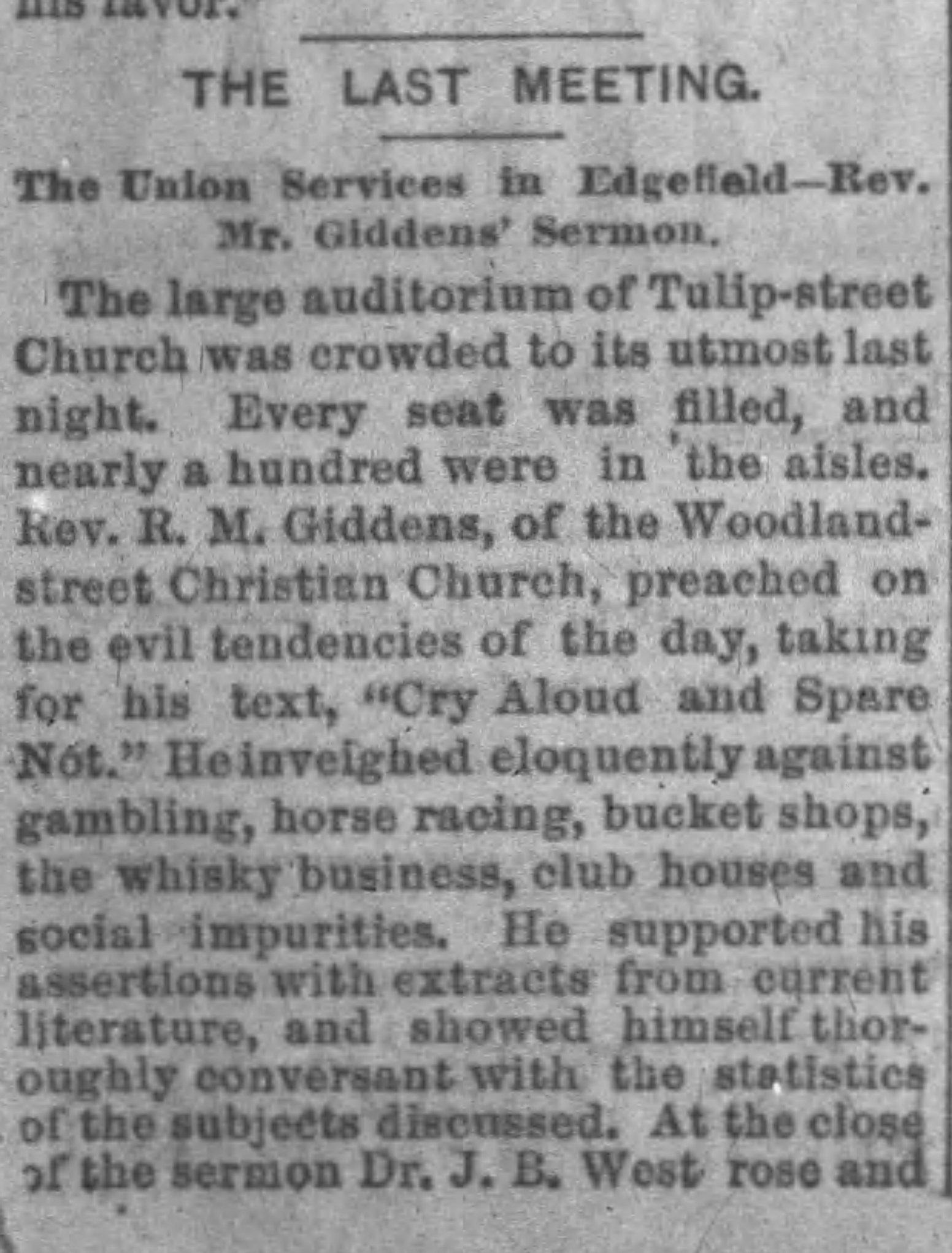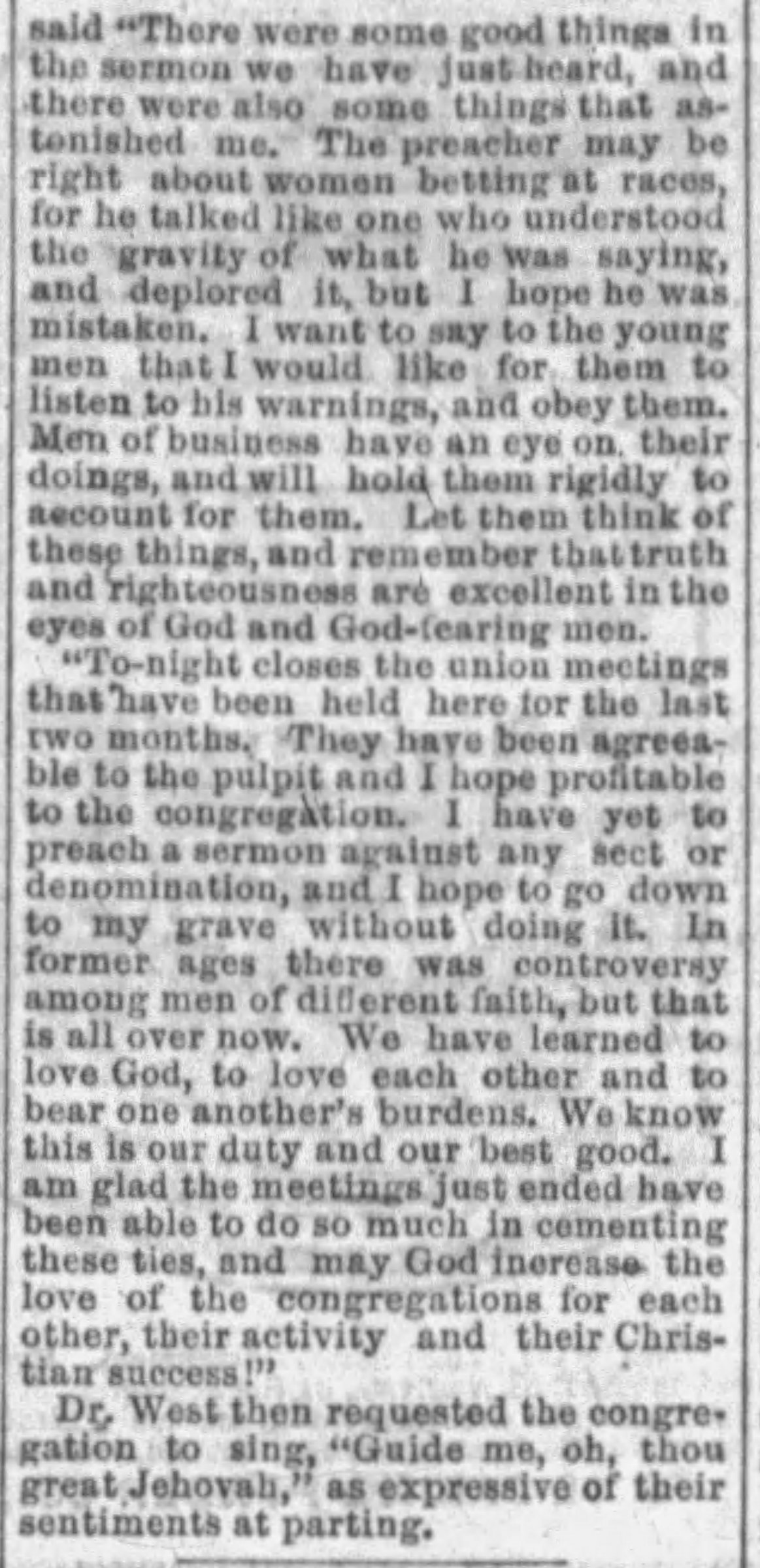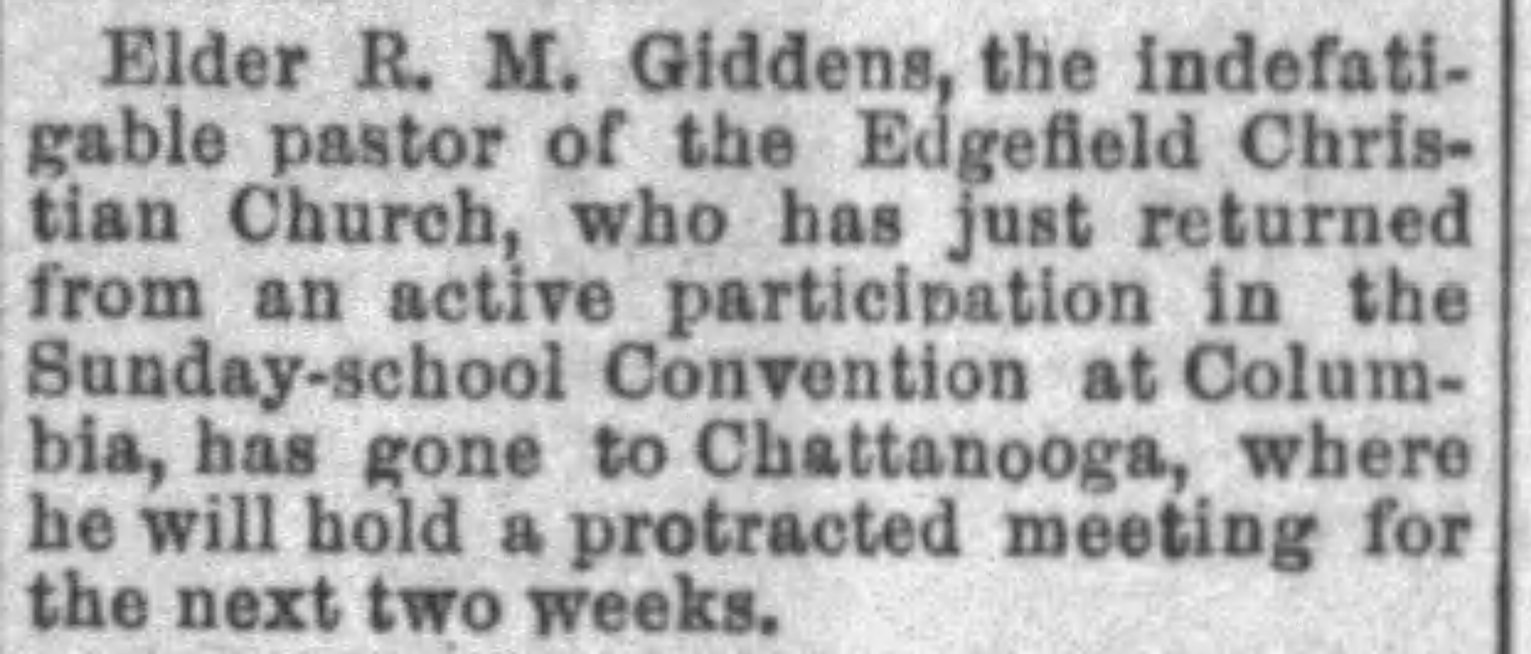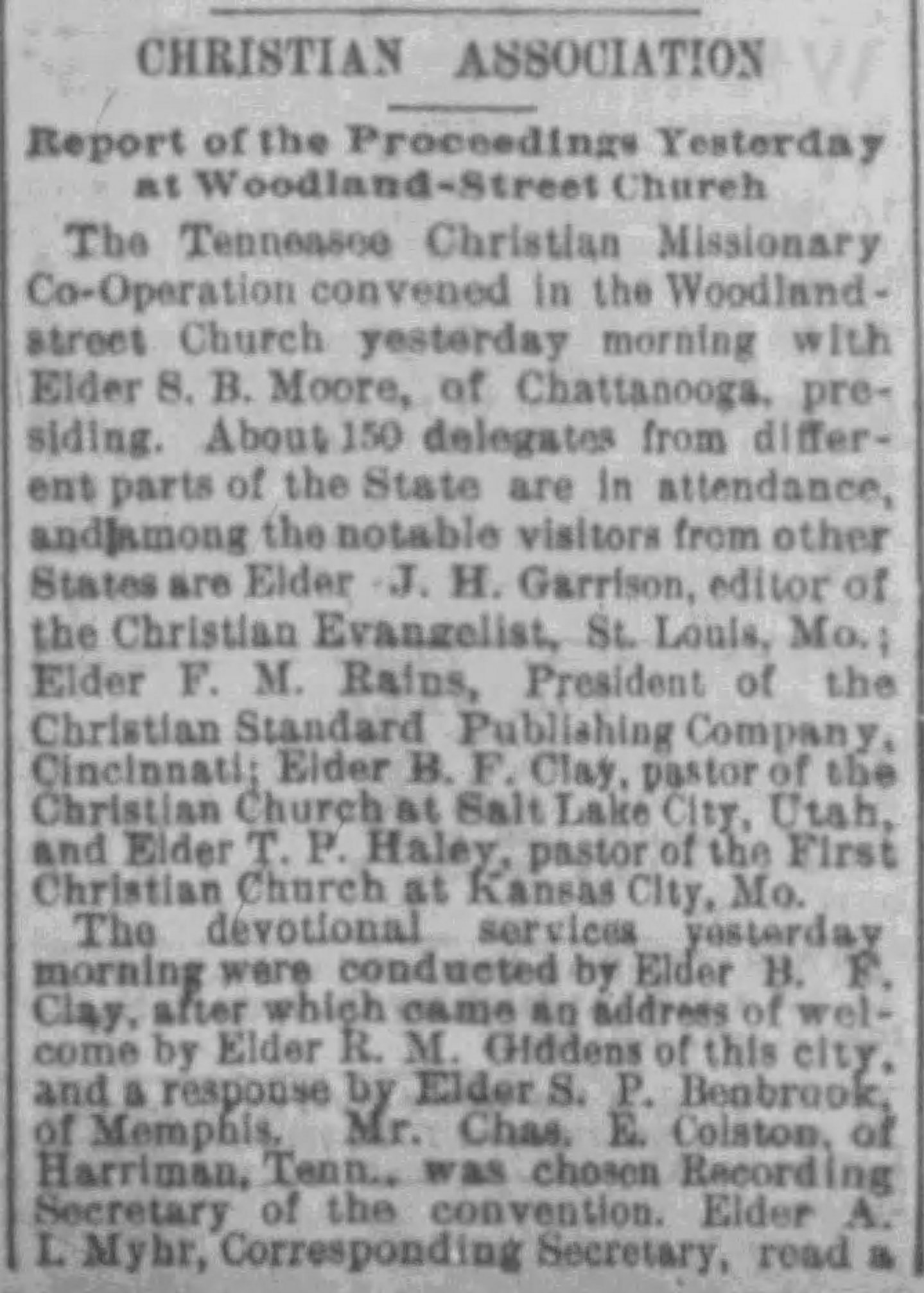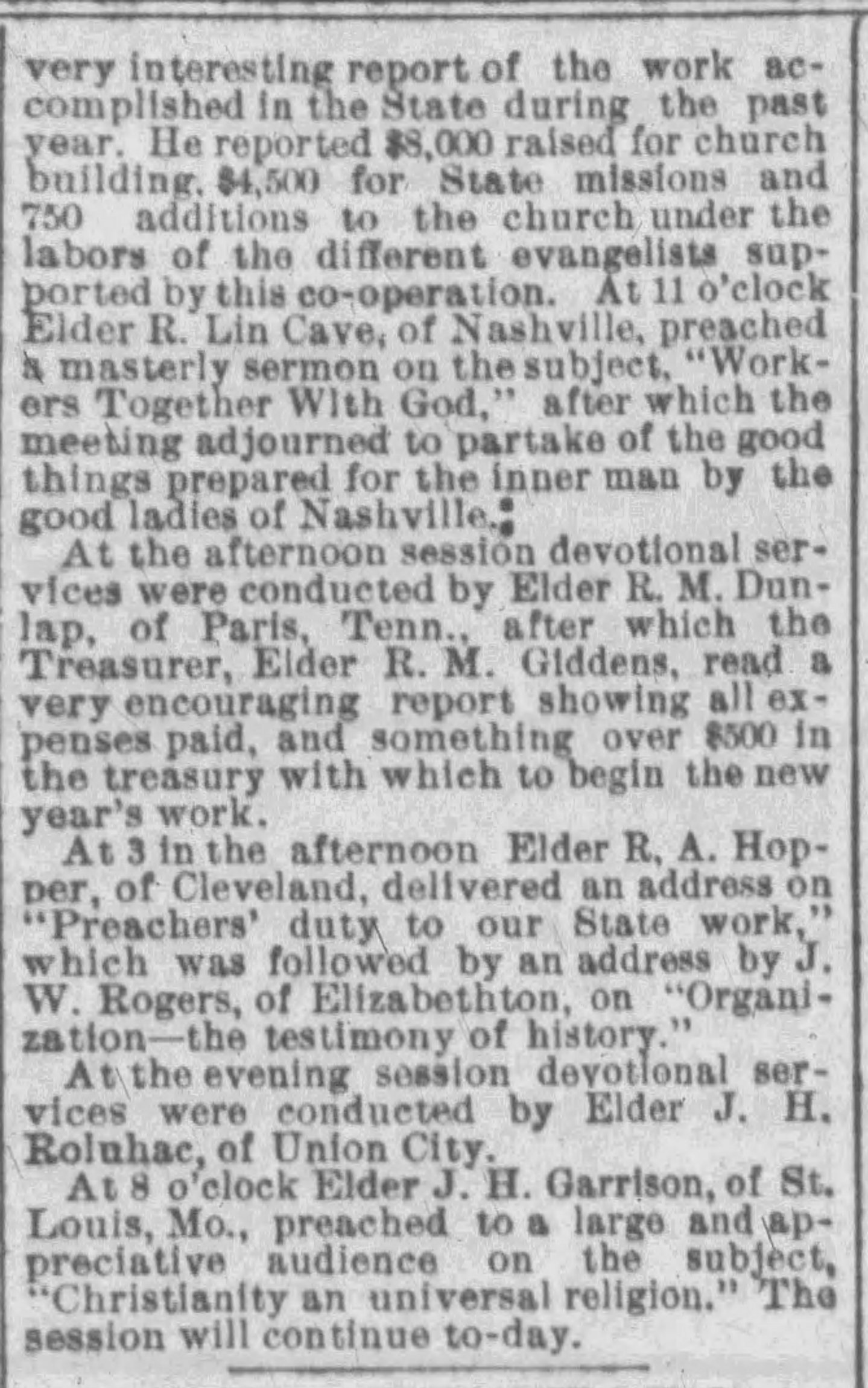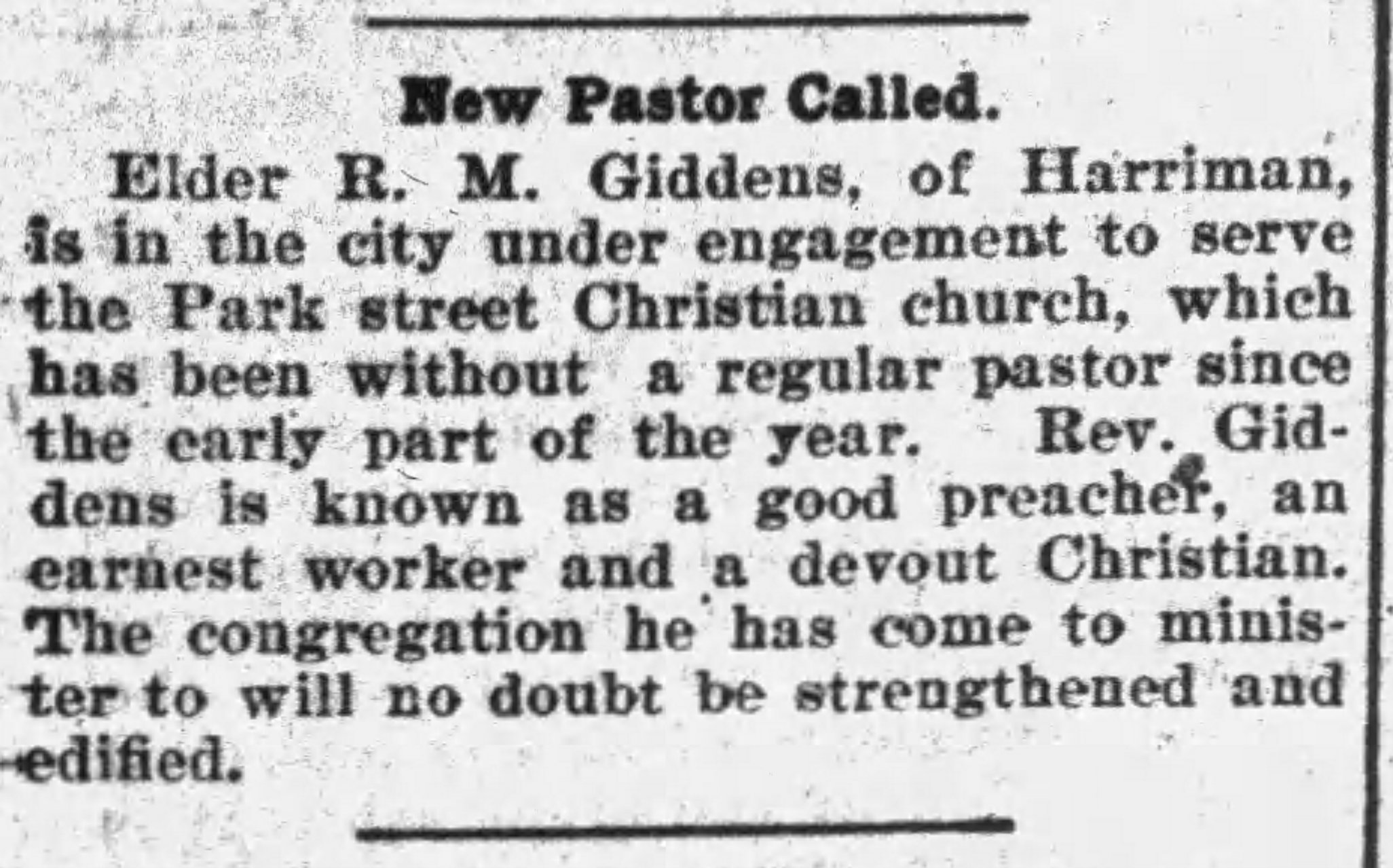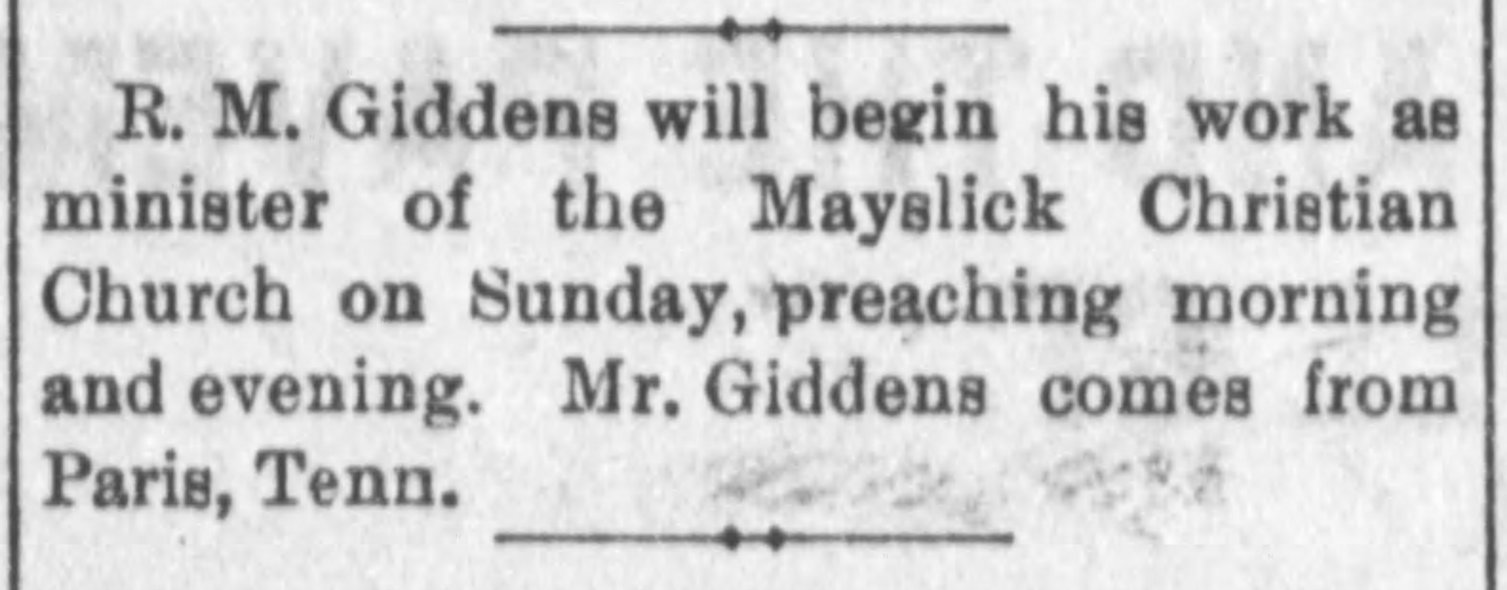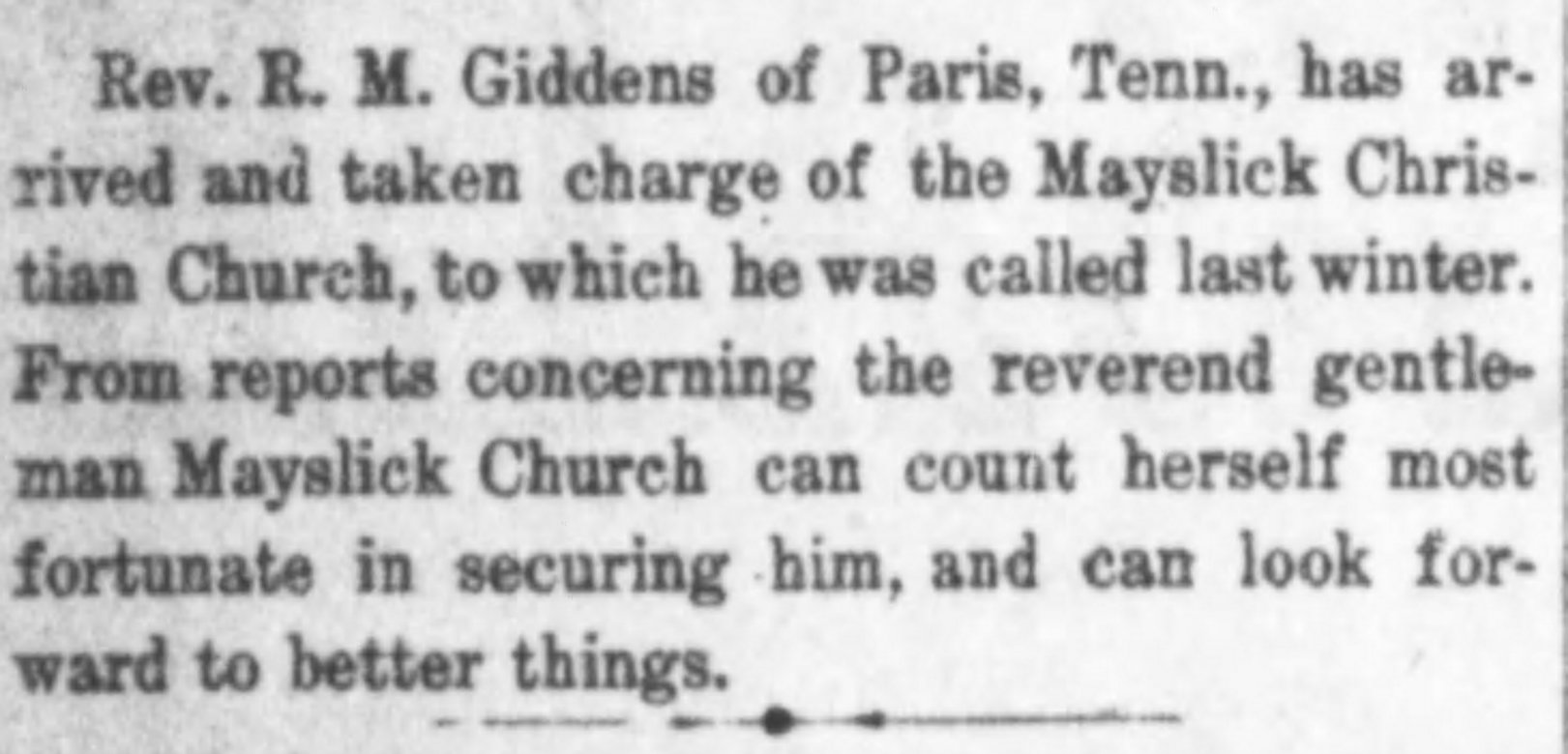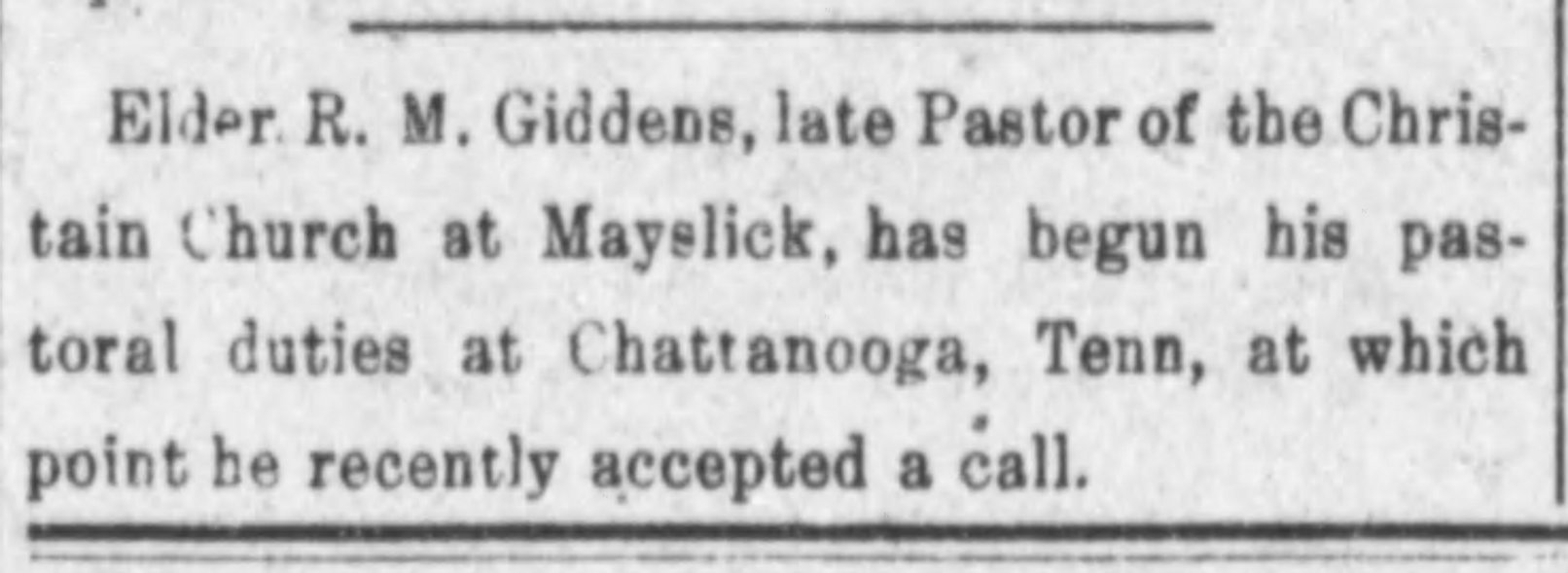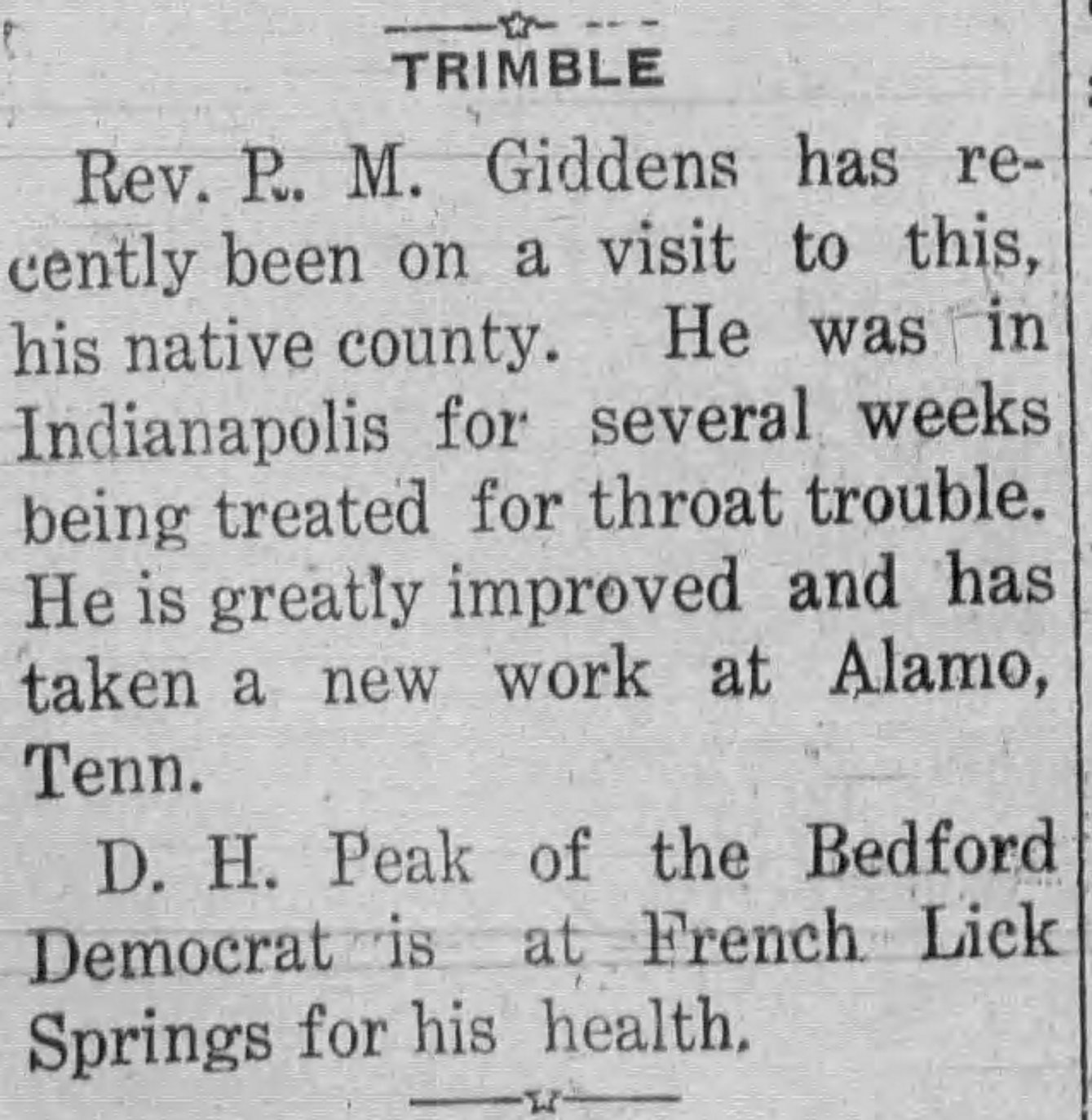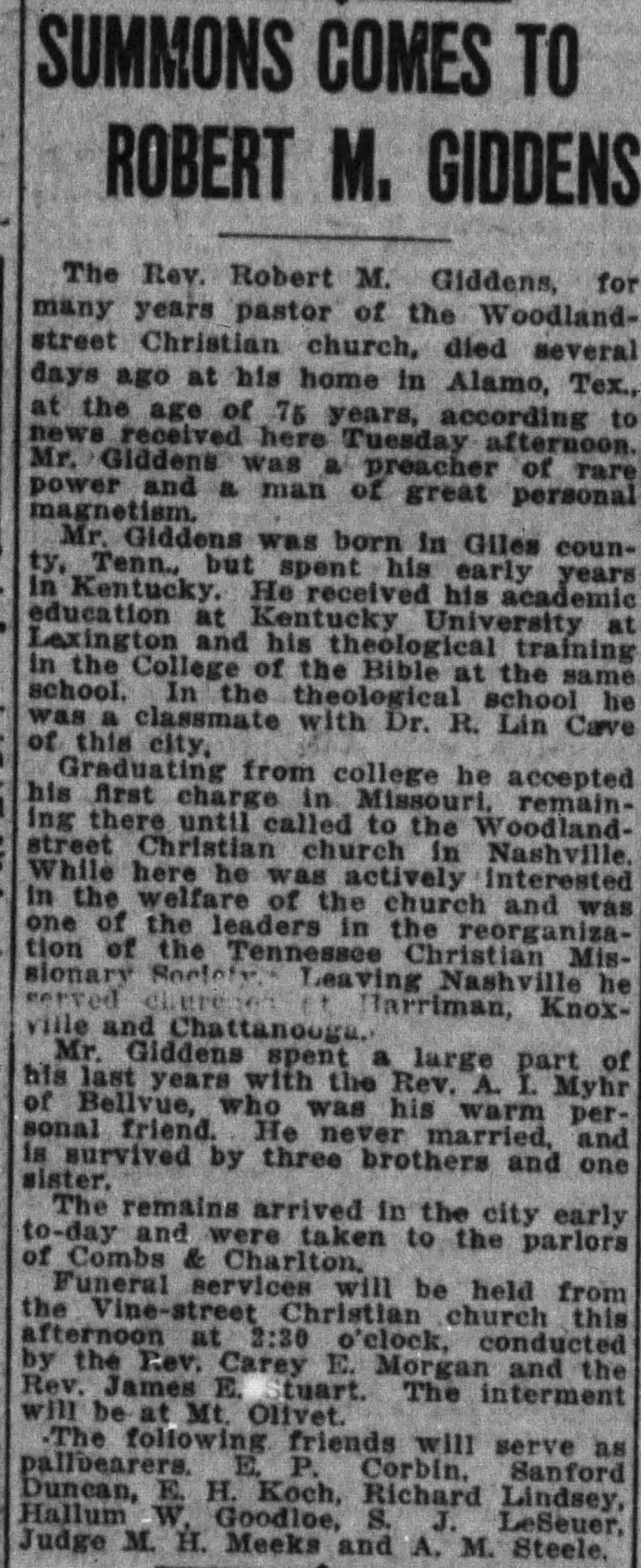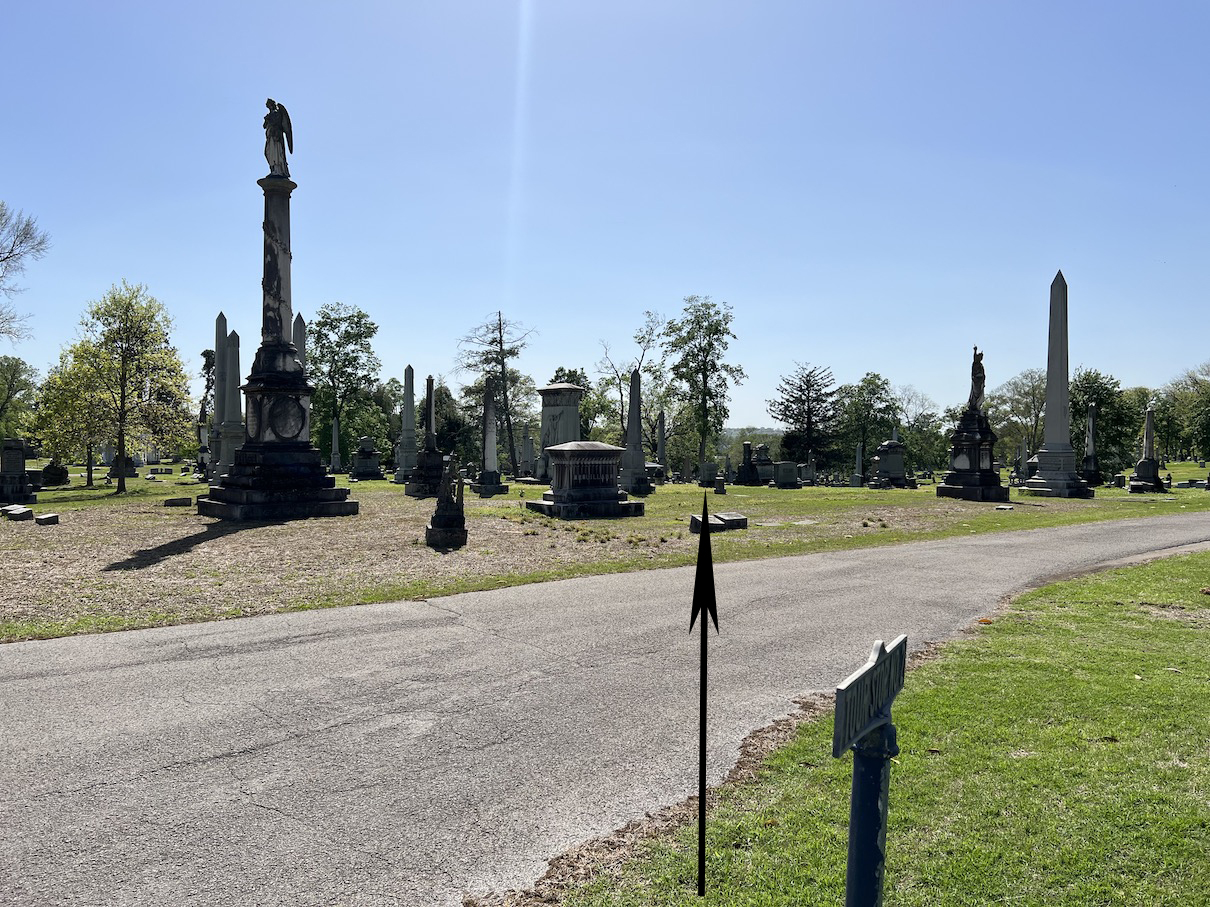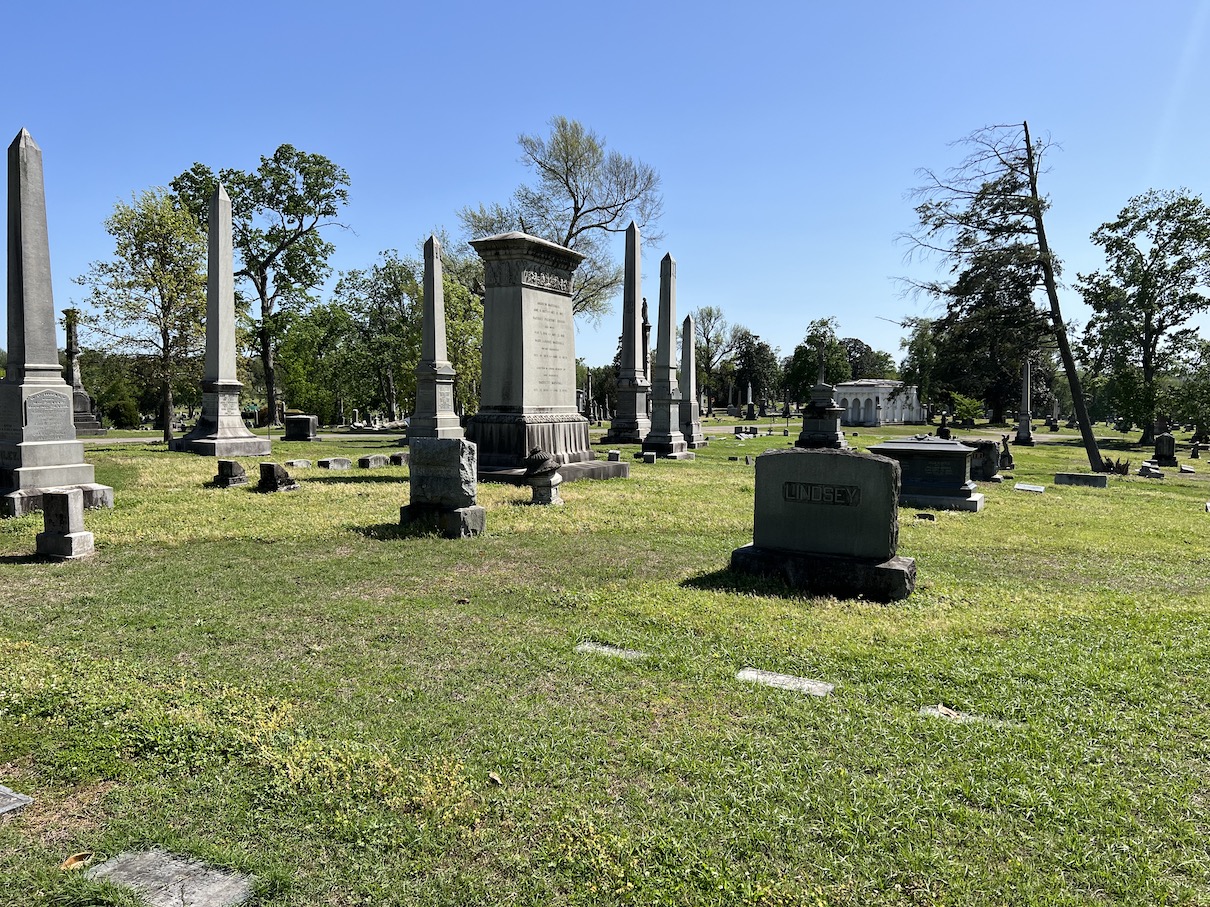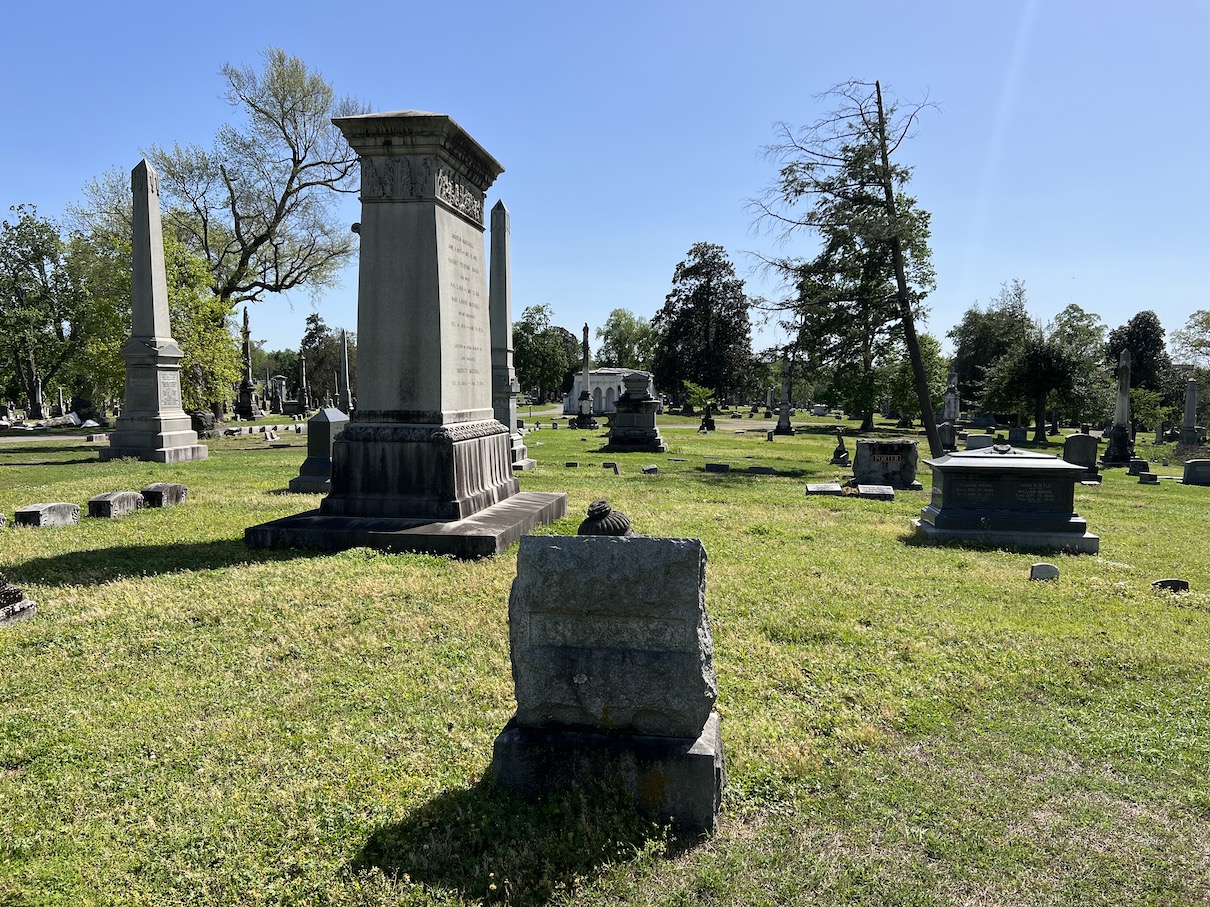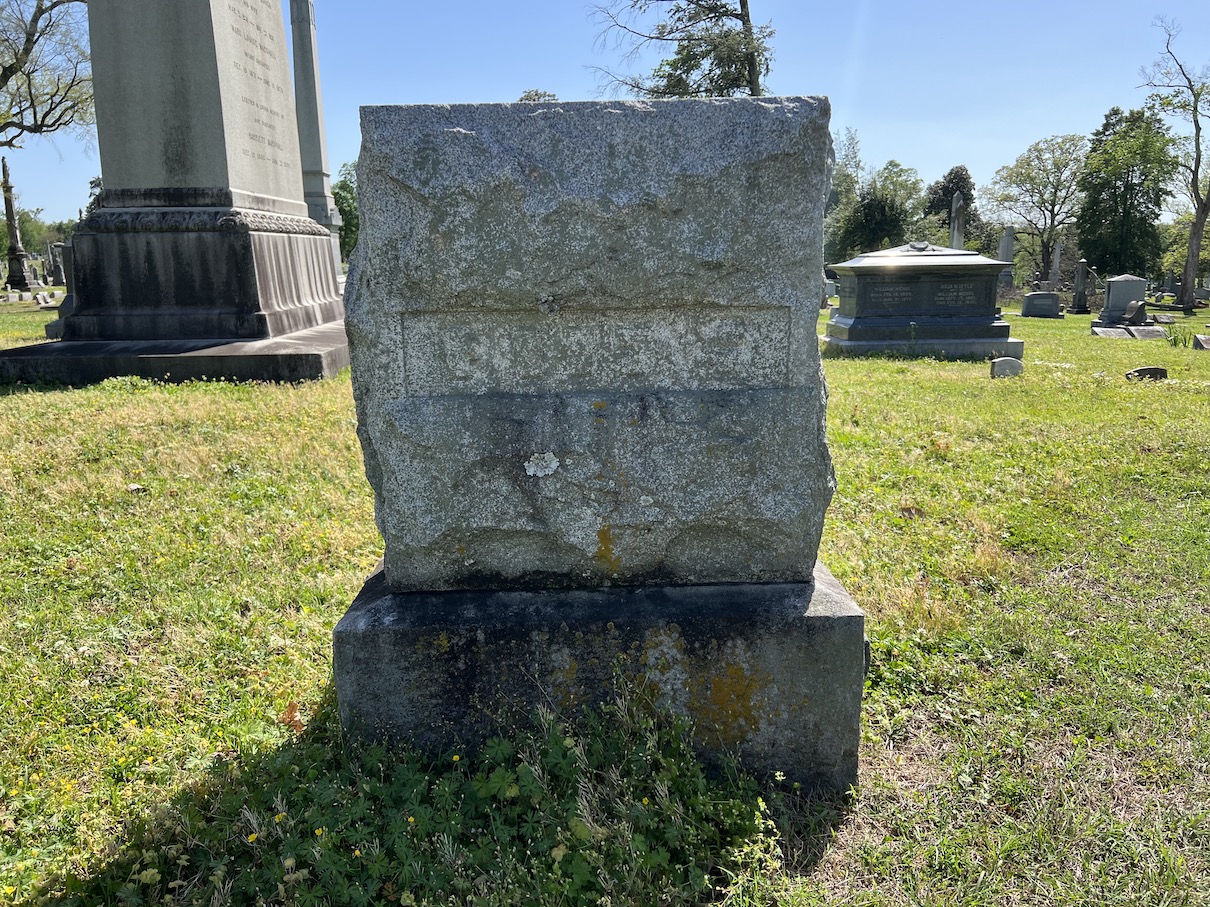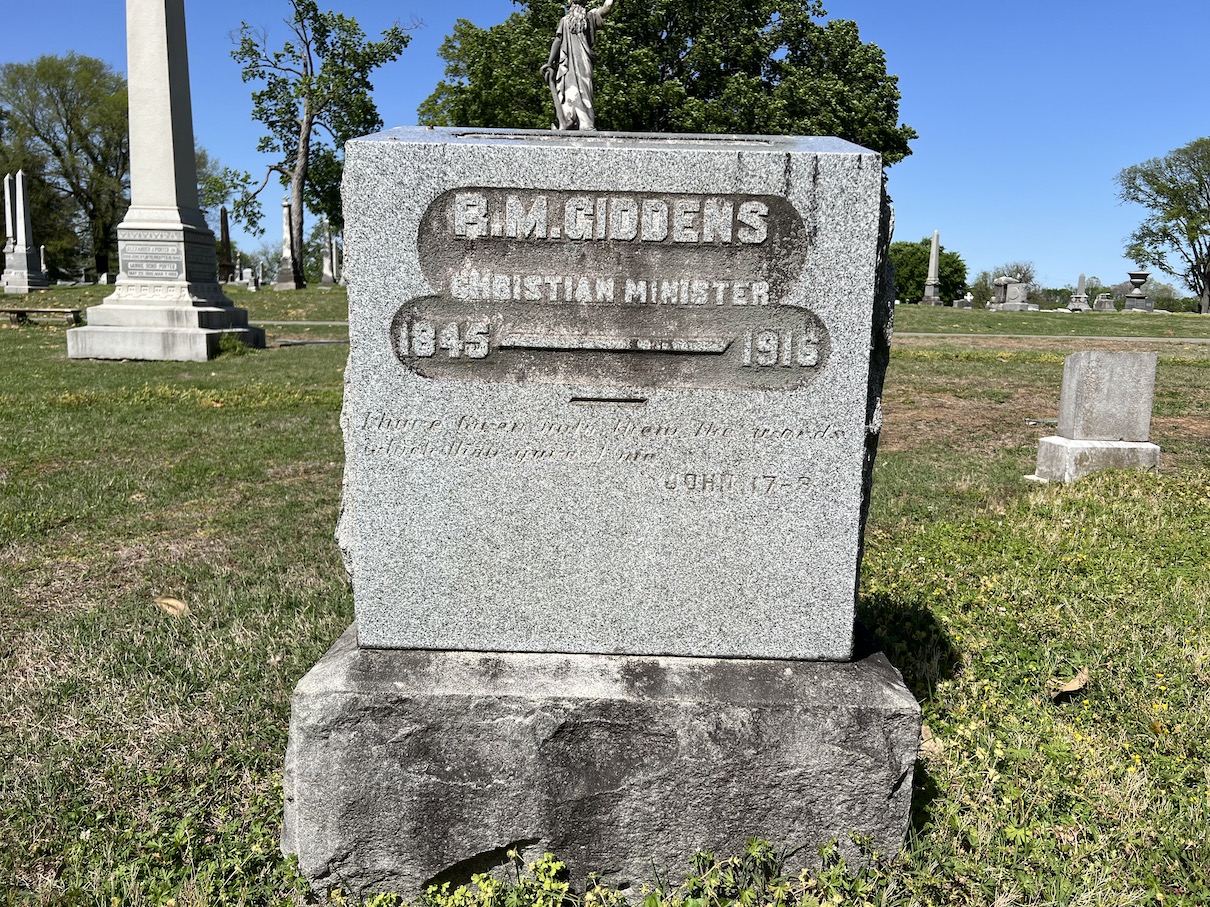Robert Melvin Giddens
1864-1916
![]()
Robert M. Giddens
1846-1916
Robert Melvin Giddens was born February 23, 1845, in Trimble County, Kentucky. He was of Scotch-Irish descent, the fourth son and child of Abner Jackson Giddens (1812-1902) and Mary "Polly" Ann Bain (1818-1874). Three older siblings were Thomas Selkire Giddens (1837-1841), James William Giddens (1839-1907), and John R. Giddens (1841-1863). Younger than he was a sister, Susan Isabell Giddens (1847-1922), a brother, Andrew Jackson Giddens (1851-1922), another brother, Thomas A. Giddens (1855-????), then Charles Clarence Giddens (1858-1933), and Sally Giddens (1860-1870), who died before reaching adulthood.
Converted to Christ at age 20, Robert entered the College of the Bible in Lexington, Kentucky. After graduating in 1872, he did post-graduate work in languages and history at Ghent College, Ghent, Ky. He had a Master's honorary degree conferred upon him in 1888 by Christian University in Canton, Missouri.
Soon after graduating from the University of Kentucky in 1872, he began preaching around his home in Trimble County, Kentucky. Then he preached for about three years in Dover, Kentucky. In 1883 he moved to Paris, Missouri to preach. He served two years as a county evangelist for Monroe County. Then he began preaching at Macon, Missouri, where he preached for four years until the end of 1886. In 1887, he moved to Nashville. The following appeared in the Nashville paper,
"The Rev. R. M. Giddens is pastor of the Woodland-street Church in East Nashville. He is a graduate of the Bible College of the Kentucky University, at Lexington, and began his work here this year only, succeeding the Rev. W. J. Loos. Woodland-street Church is about twelve years old and is succeeding admirably with a membership of 250 souls. He is regarded by these that know him as a very excellent religious church teacher and a fine pastor. He is a hard and plodding student, and withal a pleasant and instructive leader. He is about 37 years old and unmarried. His surroundings are congenial to him, and from all quarters comes high praise of the man and his work." (Christian Church, The Daily American, (Tennessean), Vol. XII, Whole No. 3,863. April 10, 1887, page 1)
For the first couple of years of his time in Nashville, the relationship between Robert and the Gospel Advocate, a Nashville-based church paper, was in good standing. He sent in reports on mission efforts as well as annually reporting a breakdown of the budget of the Woodland Street church in the pages of the Advocate.
The congregation had been planted in 1871 in the northeastern part of Nashville. For the first several years of the work, there was no preacher, only fill-ins, mainly E. G. Sewell, one of the editors of the Gospel Advocate. Also, J. C. McQuiddy, owner of the paper, attended and preached some in the congregation. In the January 23, 1889 issue of GA, page 51, the church's annual report was contributed by R. M. Giddens. Upon conclusion of the report, E. G. Sewell proceeded with the following: "It will be seen by the above that this congregation is decidedly mixed up with societies." What followed was a brief history of the congregation showing that until W. J. Loos and, later, R. M. Giddens came, the church had not contributed funds to missionary societies. Such became the seeds of separation among Nashville churches and, ultimately, R. M. Gidden's relationship with the Gospel Advocate. By the start of 1890, Giddens and the brethren at Woodland Street had started a ladies' local (Tennessee) missions society, and were contributing to the Ladies Foreign Mission Society. Not long after, Giddens and some elders went to Chattanooga to begin a state-wide mission program, called Tennessee Missionary Society.
After six years in Nashville, Robert moved to Harriman, Tennessee, near Knoxville to work for about three years. Then he moved into Knoxville to work for the Christian church meeting on the corner of Gay and Park Streets. In November 1897, he moved to Paris, Tennessee, and served the Christian Church there. While in Paris, Giddens, A. I. Myhr, and W. J. Shelburne began a Bible Institute, where they would go to congregations and schools and conduct seminars promoting instrumental music in worship and missionary societies. One such session was conducted at the Christian church in Henderson, Tennessee, on February 23, 1903. The church there had just split the previous month over the instrument.
Then, in the summer of 1903, Robert moved to take on the preaching position at Mays Lick, Kentucky. The history of the Mays Lick Christian church was rich in tradition. One of its early preachers was none other than Walter Scott, who died and was buried there in 1861. The following is taken from their official history concerning Robert Giddens, "Older by some years than the ministers who preceded him was the man who came to May's Lick in August 1903. Gentle, modest, utterly sincere, with eyes as clear as a child's, and a heart full of rare wisdom—this was Robert M. Giddens, pastor of this church for four years. Not a great preacher, he had a message worth heeding, and he is remembered as "one of the best men that ever lived." It was a devoted member of the Baptist church who told the writer how R. M. Giddens and J. P. Campbell both felt that "Our people must emphasize the things on which we agree and not those on which we disagree." Blessed with a keen sense of humor, Brother Giddens was a delightful companion with those who knew him best. A bachelor all his life, he had often been pressed for the reason, and his replies are said to have been varied and interesting. The temptation to quote one of them here is irresistible. As always, his soft drawl seemed to fit the words,—"We-ell, I've been caught in so many other wild-cat schemes, I thought I'd keep out of that." To the young lovers, in whom he took such warm interest, this was a particularly delicious bit." (Disciples Of Christ at May's Lick, Kentucky, by Robert M. Yancey, 1941, p.75)
In August 1907, Robert moved to Chattanooga and preached for the East Side and Highland Park Christian churches. Then, in 1910 he moved briefly back to his home in Trimble County, Kentucky. In 1912, he moved back to Harriman, Tennessee, briefly. At the same time, trips were made down to Chattanooga, as his ties with the Christian church there were strong. In 1915 he moved to Bells, Crockett County, in west Tennessee.
Robert never married, leaving him able to travel extensively on behalf of his ministry. He preached in meetings from Ohio to Florida and from Tennessee to Texas. He appeared in the Who's Who of Tennessee in 1911. He participated in Bible Societies and promoted unity among churches. He participated in Pastoral Societies and used the platform to encourage unity wherever he lived. Politically, he was a prohibition Democrat.
While living in Bells, Tennessee, he suffered a hemorrhage and died suddenly in the neighboring town of Alamo. His body was returned to Nashville, where it was reported in his obituary that he had formerly requested to be buried in Mt. Olivet Cemetery in the family plot of Mrs. J. W. Lindsey, the owner of a boarding house he had lived in previously, was considered a part of their family. His long-time friend and co-worker, A. I. Myhr of Bellevue, preached at the funeral.
Robert M. Giddens lived at a most fragile time in the history of the American Restoration Movement. When division among churches of Christ over the mission societies and worship practices was at its height, he was noted as being among the primary leaders, especially in Tennessee. Depending on the side in which one fell, he was lauded or blamed for his participation. Among the many leaders involved, the outcome of his ministry was the solidification of two different fellowships that came to be known as the Christian Church/Disciples of Christ and churches of Christ. In 1906, the U.S. Census formally noted these as two different church organizations.
-Scott Harp, 05.23.2023
Sources: Gospel Advocate, Ancestry.com, Newspapers.com, other references in report.
![]()
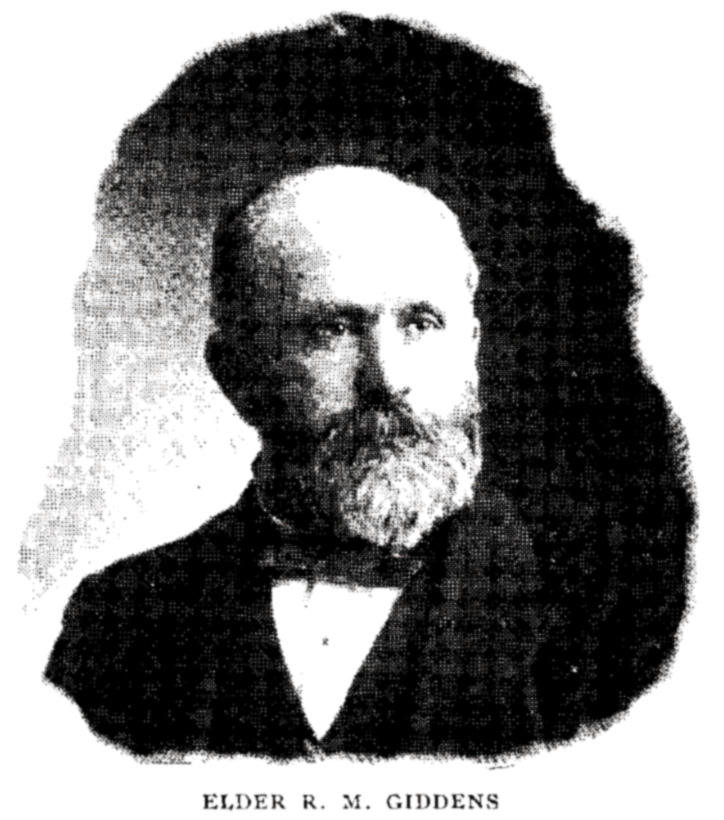
![]()
R. M. Giddens Begins Work At Woodland Street
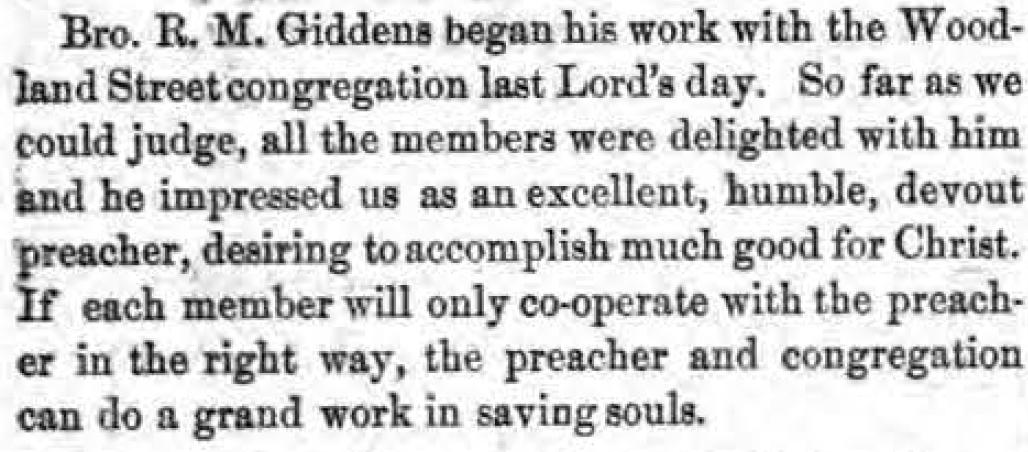
Gospel Advocate, 1877, January 12th edition, page 27
![]()
R. M. Giddens Conducts Meeting At Woodland Street

Gospel Advocate, 1877 April 20th edition, page 254
![]()
Report On Hendersonville Meeting
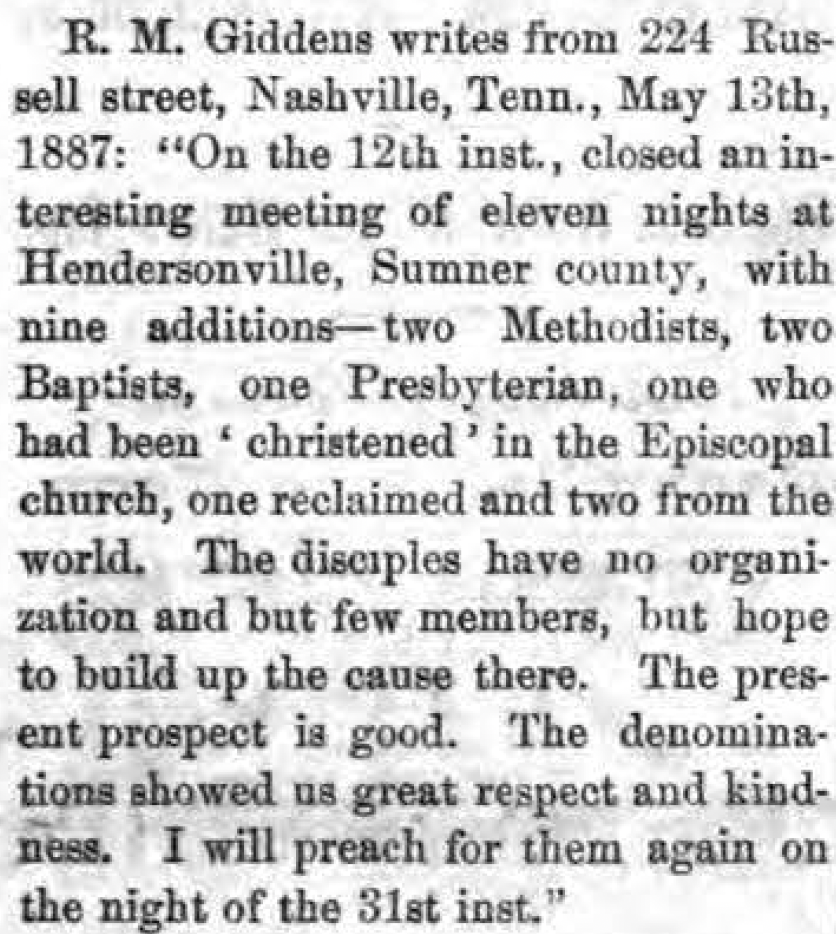
Gospel Advocate, 1877, May 18th edition, page 319
![]()
Report on Woodland Street Budget And E. G. Sewell's Comments
Gospel Advocate, 1899, January 23rd edition, page 51
![]()
Columbia Missouri Herald, Columbia, Missouri
Thursday, June 30, 1881, page 3
![]()
The Kansas City Times, Kansas City, Missouri
Friday, October 8, 1886, page 1
![]()
La Plata, Missouri, The Home Press,
Friday, November 5, 1886, page 1
![]()
The Macon Republican, Macon, Missouri
Thursday, December 16, 1886, page 3
![]()
The Daily American, (Tennessean), Nashville, Tennessee
Monday, August 26, 1889, page 7
![]()
The Daily American, (Tennessean), Nashville, Tennessee
Tuesday, November 26, 1889, page 5
![]()
The Daily American, (Tennessean), Nashville, Tennessee
Thursday, October 15, 1891, page 5
![]()
Nashville Banner, Nashville, Tennessee
Friday, April 1, 1892, page 2
![]()
The Knoxville Journal, Knoxville, Tennessee
Sunday, November 3, 1895, page 11
![]()
The Evening Bulletin
Friday, July 31, 1903, page 3
![]()
The Public Ledger, Maysville, Kentucky
Wednesday, August 5, 1903, page 2
![]()
The Public Ledger, Maysville, Kentucky
Saturday, August 3, 1907, page 2
![]()
Henry County Local, New Castle, Kentucky
Friday, May 20, 1910, page 6
![]()
The Parisian, Paris, Tennessee
Friday October 27, 1916, page 1
(click on article to read)
![]()
Nashville Banner, Nashville, Tennessee
Wednesday, October 25, 1916, page 9
![]()
Directions To Grave
R. M. Giddens is buried in Mt. Olivet Cemetery in Section 5. In Nashville, Tennessee take I-24/I-40 to Fessler's Lane. Exit and head north. Go 2 traffic lights, until it dead end into Lebanon Pike, and turn right. You will soon see a cemetery on the right. This is Calvary. Keep going to the next cemetery entrance on the right. This will be Mt. Olivet. Go into the drive until dead end and turn right. Begin winding up the hill until you see the vast field of marker and make a hard right. You will have Section 1 on your right and section 5 on your left. Giddens is in Section five, easily seen from the road. His monument is in the LINDSEY family plot.
GPS Location
36°09'02.7"N 86°44'03.5"W
or D.d. 36.150746, -86.734318
![]()
R. M. GIDDENS
Christian Minister
1845-1916
I have given unto them the words which thou gavest me. John 17:8
![]()
Photos Taken 04.17.2023
Webpage produced 05.23.2023
Courtesy Of Scott Harp
www.TheRestorationMovement.com
![]()
